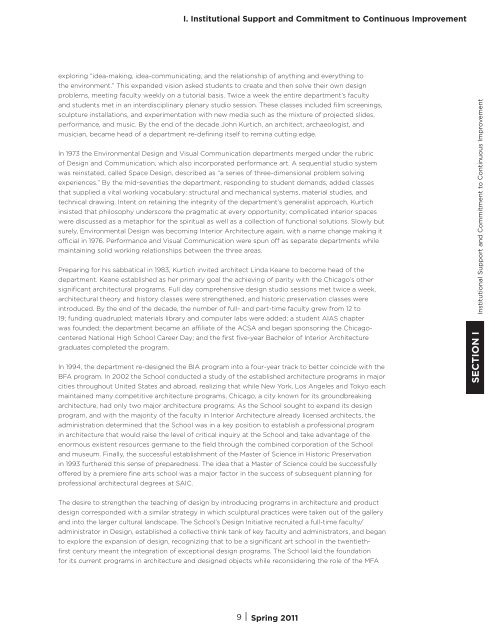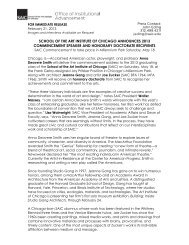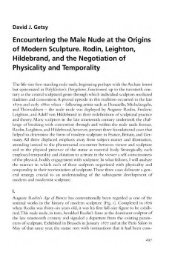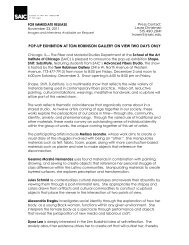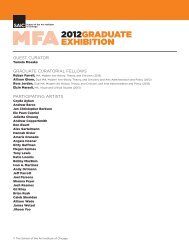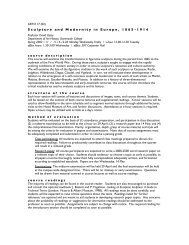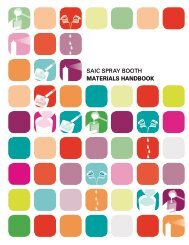i. institutional support and commitment to continuous improvement
i. institutional support and commitment to continuous improvement
i. institutional support and commitment to continuous improvement
Create successful ePaper yourself
Turn your PDF publications into a flip-book with our unique Google optimized e-Paper software.
I. Institutional Support <strong>and</strong> Commitment <strong>to</strong> Continuous Improvement<br />
exploring “idea-making, idea-communicating, <strong>and</strong> the relationship of anything <strong>and</strong> everything <strong>to</strong><br />
the environment.” This exp<strong>and</strong>ed vision asked students <strong>to</strong> create <strong>and</strong> then solve their own design<br />
problems, meeting faculty weekly on a tu<strong>to</strong>rial basis. Twice a week the entire department’s faculty<br />
<strong>and</strong> students met in an interdisciplinary plenary studio session. These classes included film screenings,<br />
sculpture installations, <strong>and</strong> experimentation with new media such as the mixture of projected slides,<br />
performance, <strong>and</strong> music. By the end of the decade John Kurtich, an architect, archaeologist, <strong>and</strong><br />
musician, became head of a department re-defining itself <strong>to</strong> remina cutting edge.<br />
In 1973 the Environmental Design <strong>and</strong> Visual Communication departments merged under the rubric<br />
of Design <strong>and</strong> Communication, which also incorporated performance art. A sequential studio system<br />
was reinstated, called Space Design, described as “a series of three-dimensional problem solving<br />
experiences.” By the mid-seventies the department, responding <strong>to</strong> student dem<strong>and</strong>s, added classes<br />
that supplied a vital working vocabulary: structural <strong>and</strong> mechanical systems, material studies, <strong>and</strong><br />
technical drawing. Intent on retaining the integrity of the department’s generalist approach, Kurtich<br />
insisted that philosophy underscore the pragmatic at every opportunity; complicated interior spaces<br />
were discussed as a metaphor for the spiritual as well as a collection of functional solutions. Slowly but<br />
surely, Environmental Design was becoming Interior Architecture again, with a name change making it<br />
official in 1976. Performance <strong>and</strong> Visual Communication were spun off as separate departments while<br />
maintaining solid working relationships between the three areas.<br />
Preparing for his sabbatical in 1983, Kurtich invited architect Linda Keane <strong>to</strong> become head of the<br />
department. Keane established as her primary goal the achieving of parity with the Chicago’s other<br />
significant architectural programs. Full day comprehensive design studio sessions met twice a week,<br />
architectural theory <strong>and</strong> his<strong>to</strong>ry classes were strengthened, <strong>and</strong> his<strong>to</strong>ric preservation classes were<br />
introduced. By the end of the decade, the number of full- <strong>and</strong> part-time faculty grew from 12 <strong>to</strong><br />
19; funding quadrupled; materials library <strong>and</strong> computer labs were added; a student AIAS chapter<br />
was founded; the department became an affiliate of the ACSA <strong>and</strong> began sponsoring the Chicago-<br />
centered National High School Career Day; <strong>and</strong> the first five-year Bachelor of Interior Architecture<br />
graduates completed the program.<br />
In 1994, the department re-designed the BIA program in<strong>to</strong> a four-year track <strong>to</strong> better coincide with the<br />
BFA program. In 2002 the School conducted a study of the established architecture programs in major<br />
cities throughout United States <strong>and</strong> abroad, realizing that while New York, Los Angeles <strong>and</strong> Tokyo each<br />
maintained many competitive architecture programs, Chicago, a city known for its groundbreaking<br />
architecture, had only two major architecture programs. As the School sought <strong>to</strong> exp<strong>and</strong> its design<br />
program, <strong>and</strong> with the majority of the faculty in Interior Architecture already licensed architects, the<br />
administration determined that the School was in a key position <strong>to</strong> establish a professional program<br />
in architecture that would raise the level of critical inquiry at the School <strong>and</strong> take advantage of the<br />
enormous existent resources germane <strong>to</strong> the field through the combined corporation of the School<br />
<strong>and</strong> museum. Finally, the successful establishment of the Master of Science in His<strong>to</strong>ric Preservation<br />
in 1993 furthered this sense of preparedness. The idea that a Master of Science could be successfully<br />
offered by a premiere fine arts school was a major fac<strong>to</strong>r in the success of subsequent planning for<br />
professional architectural degrees at SAIC.<br />
The desire <strong>to</strong> strengthen the teaching of design by introducing programs in architecture <strong>and</strong> product<br />
design corresponded with a similar strategy in which sculptural practices were taken out of the gallery<br />
<strong>and</strong> in<strong>to</strong> the larger cultural l<strong>and</strong>scape. The School’s Design Initiative recruited a full-time faculty/<br />
administra<strong>to</strong>r in Design, established a collective think tank of key faculty <strong>and</strong> administra<strong>to</strong>rs, <strong>and</strong> began<br />
<strong>to</strong> explore the expansion of design, recognizing that <strong>to</strong> be a significant art school in the twentieth-<br />
first century meant the integration of exceptional design programs. The School laid the foundation<br />
for its current programs in architecture <strong>and</strong> designed objects while reconsidering the role of the MFA<br />
9 | Spring 2011<br />
SECTION I Institutional Support <strong>and</strong> Commitment <strong>to</strong> Continuous Improvement


